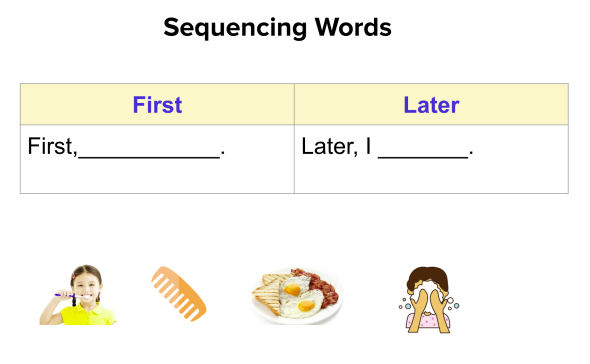
Overview
Designated English Language Development (D-ELD) is a required protected time (a minimum of 30 minutes daily) to support multilingual learners (or ELLs) to achieve English proficiency until reclassification. During this time, students are grouped by English language proficiency for instruction.

Every lesson has a language objective and emphasizes student language production using collaborative structures in which students have multiple opportunities to use the focal language and receive real-time authentic modeling and feedback. While all students are developing language proficiency, multilingual learners (students that are learning English as an additional language) need specific and systematic instruction about language.
Priority Standards Link to this section
What students will know, what students will do, and what thinking skills students will develop to apply and transfer English Language Development understandings that endure within the discipline, leverage deeper understandings, and/or support readiness for success at the next grade level.
In first grade, focus on these critical areas:

Interacting In Meaningful Ways
- Collaborative & Productive: Exchanging information and ideas, offering opinions, and supporting ideas & opinions through collaborative discussion
- Interpretive & Productive: Listening actively and reading & viewing closely a wide variety of text and other media. Asking and answering detailed questions, restating & paraphrasing - describing ideas, experiences, and key details. Planning and presenting brief oral presentations - retelling texts and recounting experiences using complete sentences and keywords with a scaffold

Learning How English Works
- Text Structure: Apply understanding of how text types are organized. (e.g. narrative-beg./mid/end) Apply the understanding of how ideas, events, or reasons are linked by connecting words or phrases(e.g. First, next, then, last/finally, after, one day, a long time ago)
- Using Verbs & Verb Phrases: Doing, saying, being/having, thinking/feeling; Past tense (retell story/recount experience); Simple present tense (descriptions/explanation)

- Using Nouns & Noun Phrases and Modifying to Add Details: Use adjectives/prepositions/Prepositional phrases (e.g., time, manner, place, cause) to expand sentences
- Connecting Ideas: Use conjunctions to make compound sentences. (e.g. and, but, because, so)

Using Foundational Literacy Skills
- Demonstrate understanding of the organization and basic features of print
- Demonstrate understanding of spoken words, syllables, and sounds (phonemes)
- Know and apply grade-level phonics and word analysis skills in decoding words
- Read with sufficient accuracy and fluency to support comprehension
- Students in Spanish biliteracy and dual language programs need sound transfer skills and crosslinguistic transfer.
Instruction: Signature Elements Link to this section
Below are signature elements of SFUSD English Language Development instruction that students should experience regularly throughout first grade as they develop as English readers, writers, speakers, & listeners.
Language Objectives
Multilingual learners, like all students, benefit when they know they will learn and what is expected from them. All lessons throughout the day should have a clear language objective.

Foundational Skills Routines
Quick routines to introduce/teach/review phonological knowledge (letter names, sounds, phonemic awareness, high-frequency words, etc.)

Explicitly Teach Language Specific Skills
Language instruction should focus on one of the three levels of academic language:
- Word/Phrase: verbs (simple present/past tense), adjectives, and prepositional phrases (e.g., time, manner, place, cause)
- Sentence Structure: simple sentences and compound sentences using conjunctions (and, but, because, so, etc.)
- Text Structure: Structure of the text, pronouns, and transitional words & text connectives (e.g. first/next/then, last/finally, after, then, one day)
Collaboration & Engagement
The teacher guides students into discussions/conversations about the focal language. Students have multiple opportunities to use the focal language in a collaborative structure.

Formative Assessment
Opportunity for students to demonstrate their learning. For first grade, days 1-4 should focus on oral production, and day 5 should focus on the written form where students use the learned language specific to the week.
Materials
Below are items you should have to support your students' English Language Development instruction. If you are missing anything from the list, please first contact your site administrator or designated support. If they are unable to resolve the issue promptly, please contact the SFUSD Multilingual Pathways ELD Team.
- Digital Wonders Materials (how to access)
- First Grade Wonders Big Books
- Class Set of Wonders Workbooks
- Academic Conversation Posters
English Language Development Units
Planning Guide
Reflection Questions Link to this section
- How are students' developmental needs, communities, and experiences being reflected and honored, or how could they be?
- What opportunities do you see for developing equitable access & demand, inquiry, collaboration, and assessment for learning?
- What are the implications for your own practice? What strengths can you build upon? What will you do first?
Want More?
Standards
More Resources
- Reclassification
- Collaboration: Getting Started
- Assessment: Exit Ticket Observation Tool
- Guiding Principals for Dual Language Program
Contact the Multilingual Pathways ELD Team:
This page was last updated on May 17, 2023

